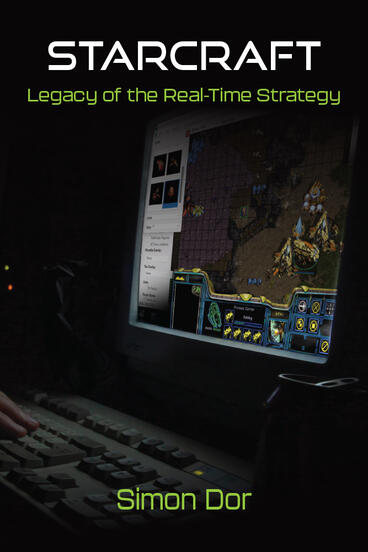StarCraft
Legacy of the Real-Time Strategy
One game’s influence on the rise of e-sports and video game strategy
Description
StarCraft (Blizzard Entertainment, 1998) is a real-time strategy video game, placing the player in command of three extraterrestrial races fighting against each other for strategic control of resources, terrain, and power. Simon Dor examines the game’s unanticipated effect by delving into the history of the game and the two core competencies it encouraged: decoding and foreseeing. Although StarCraft was not designed as an e-sport, its role in developing foreseeing skills helped give rise to one of the earliest e-sport communities in South Korea.
Apart from the game’s clear landmark status, StarCraft offers a unique insight into changes in gaming culture and, more broadly, the marketability and profit of previously niche areas of interest. The book places StarCraft in the history of real-time strategy games in the 1990s—Dune II, Command & Conquer, Age of Empires—in terms of visual style, narrative tropes, and control. It shows how design decisions, technological infrastructures, and a strong contribution from its gaming community through Battle.net and its campaign editor were necessary conditions for the flexibility it needed to grow its success. In exploring the fanatic clusters of competitive players who formed the first tournaments and professionalized gaming, StarCraft shows that the game was key to the transition towards foreseeing play and essential to competitive gaming and e-sports.
Simon Dor is Associate Professor of video game studies at the Université du Québec en Abitibi-Témiscamingue.
Reviews
"This book is poised to make a significant contribution to the history of games, and the study of the social and cultural dimensions of games and gaming. The distinction of decoding and foreseeing playstyles is valuable for its recognition of how play defines games, both in terms of circulating and establishing a particular set of social uses and as it impacts the continued development of a game and franchise."
- Gerald Voorhees
—Gerald Voorhees, University of Waterloo
“Dor effectively highlights StarCraft’s complex and longstanding competitive gameplay landscape, emphasizing timing, anticipation, habits, power, and control within its multifaceted play cultures. Each chapter gleams with the essential minerals of early e-sports, offering invaluable insights and historical gems about game design and the vibrant game cultures that accompanied StarCraft’s ascent as a premier online multiplayer strategy game.”
- Emma Witkowski
—Emma Witkowski, RMIT University
“Simon Dor’s love for the game comes through every page of StarCraft: Legacy of the Real-Time Strategy. Dor takes special care to push back on a singular historical account of this landmark game, and show the ways StarCraft has played an important role through multiple cultural touchpoints and references, including his own. The book is a treat to read, weaving together the rich histories surrounding StarCraft and, very importantly, what the game’s legacy has come to mean worldwide. This work is sure to both edify and delight those who study games and longtime StarCraft enthusiasts alike.”
- Florence M. Chee
—Florence M. Chee, Loyola University Chicago, author of Digital Game Culture in Korea: The Social at Play
"Blizzard’s Starcraft has, since its launch in 1998, been bedeviled by a split assessment as both the ultimate game in the real-time strategy genre and as a derivative of earlier games. Simon Dor embraces this division by characterizing Starcraft’s significance as transitional on many levels. We learn from his deep analysis of the move from solo to multiplayer gaming, the origins of e-sports, the rise of South Korea as a competitive gaming powerhouse, and players as a creative force in a complex, emerging gaming ecosystem. This list of topics demonstrates that this now 25-year-old game is still very relevant for game studies."
- Henry Lowood
-Henry Lowood, Stanford University Libraries

